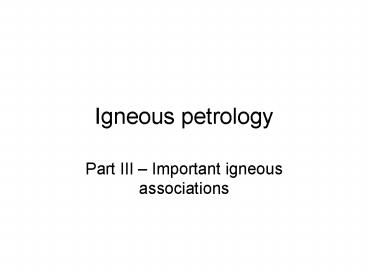Igneous petrology - PowerPoint PPT Presentation
1 / 69
Title:
Igneous petrology
Description:
Title: Granites and collisions Author: Information Technology Last modified by: Information Technology Created Date: 4/6/2006 1:53:40 PM Document presentation format – PowerPoint PPT presentation
Number of Views:522
Avg rating:3.0/5.0
Title: Igneous petrology
1
Igneous petrology
- Part III Important igneous associations
2
- Granites (and convergence/collision)
- Ophiolites (oceanic crust) and MORB (Mid-ocean
ridge basalts) - Layered igneous complexes (intra-plate, economic
importance) - Oceanic island basalts (OIB) (intraplate)
- Continental alkali series (intraplate)
- Andesites (active subductions)
- Continental arcs (active subductions)
- TTG (Archaean)
- Komatiites (Archaean)
3
Granites and collisions
- Exemple of the Himalaya
4
- Granites are typically associated to convergent
plate boundaries - Different types form at different moments of the
convergence - Example of an active collision zone the Himalaya
5
Subducting oceanic lithosphere deforms sediment
at edge of continental plate
Collision welding together of continental crust
Post-collision two continental plates are
welded together, mountain stands where once was
ocean
6
Rifting of continental crust to form a new ocean
basin
7
The Himalayas geodynamic context
- India-Eurasia convergence
- Destruction of the Tethys ocean
- Subduction stage (gt 100 Ma 25 Ma
Cretaceous-Oligocene) - Collision stage (25 Ma present Miocene and
Pliocene) - Post-collision stage (present)
8
Himalayan collision
9
(No Transcript)
10
Remontéedel Indeet collision à55 Ma
11
(No Transcript)
12
The subduction stage
Les témoins de la subduction de l Inde sous
l Asie
13
(No Transcript)
14
The collision stage
Les témoins de la collision continentale
15
(No Transcript)
16
(No Transcript)
17
(No Transcript)
18
The late to post collision stage
19
(No Transcript)
20
Successive magmatic associations (mostly
granites!)
150 125 100 75
50 25 0 tps (Ma)
21
Subduction stage
- Trans-Himalayan batholith
- Cretaceous-Oligocene
- Similar to Andean or Cordileran (California,
British Columbia, Japan) plutons - I-types (Andean)
22
Diorites Tonalites Granodiorites Granites
23
Hornblende granodiorite
Hbl-Biotite granodiorite
24
(No Transcript)
25
(No Transcript)
26
Cpx Hbl Bt
27
(No Transcript)
28
Major elements
- .. See assignment
29
Trace elements
30
(No Transcript)
31
Isotopes
- Mixed sources (mantle some crust ?)
32
Origin
- Will be discussed during the subduction
lectures
33
(No Transcript)
34
Successive magmatic associations (mostly
granites!)
150 125 100 75
50 25 0 tps (Ma)
35
Collision stage
- High Himalaya leucogranites
- Miocene
- S-type
36
Granites Alk. Granites Granodiorites
37
(No Transcript)
38
(No Transcript)
39
(No Transcript)
40
(No Transcript)
41
(No Transcript)
42
(No Transcript)
43
2 micas granites
Tourmaline granite
44
- Biotite
- Muscovite
- Tourmaline
- Garnet
- (Cordierite)
45
Major elements
- .. See assignment
46
Trace elements
47
(No Transcript)
48
Isotopes
- Very crustal
49
Origin
1. Lesser Himalaya 2. Formation I (Greywackes et
métapélites) 3. Formation II (Gneiss
calciques) 4. Formation III (Orthogneiss) 5.
Sédiments tibétains 6. Leucogranite du Manaslu 7.
Dykes
Dalle du Tibet
50
Les granites syncollisionels du Haut Himalaya
Migmatites de la formation I
51
Successive magmatic associations (mostly
granites!)
150 125 100 75
50 25 0 tps (Ma)
52
Late to post-collision stage
- Syenites and alkali granites
- Miocene to present
- A-type
- N.B. Some sub-alkali , Mg-K I-types (cf.
Vredenburg pluton as seen in Paternoster) are
also emplaced at this stage
53
Le magmatisme post-collisionel himalayen Cas
du magmatisme Néogène du Sud Karakorum
54
Syenites Qtz. Syenites Granites Alk. granites
55
Cpx, Fe-rich Sometimes Na-Cpx or Amph Little/no
plag
(Riebeckite, Aegyrine Ardfersonite)
56
(No Transcript)
57
(No Transcript)
58
Major elements
- .. See assignment
59
Trace elements
60
(No Transcript)
61
Isotopes
Composite (mantle crust), with some
mantle-derived units and some crustal units
62
Origin
- Shear heating
- Slab breakoff
63
Shear heating ?
Chaleur de frottement
64
Slab breakoff
65
Conclusion a succession of granite types
- Subduction (pre-collision) I andean
- Syn-collision S-type leucogranites
- Post-collision A (and I Mg-K )
This is, of course, a very simplified view !
66
Trace elements are markers
- Of the different types of magmas
- Of their origin
67
- Ba fluid mobile element
- Rb strongly incomp.element
68
- Zr fluid immobile,relatively depelted in the
crust but not in the mantle
69
Assignment for this week
- Read from J.D. Winter, Chapter 18, pages 343361
- Material available for discussion
- Thin sections and samples of Cape Granite Suite
I, A and S granites, to be used as examples - Your field observations, photos and notes from 1
and 2 April - An excel table with composition of examples of I,
S and A granites - This lecture, for additional examples.
- Assignment
- Propose a comparison table for I, S and A
granites, including - Field characteristics
- Mineralogy texture
- Chemical and/or normative composition
- Possible sources and evolution of the magmas
- Typical geodynamical context or contexts
- And any other interesting features you can think
of ! - Obviously, you will need either a very big table,
or a lot of attached explanatory notes, graphs,
sketches, etc































